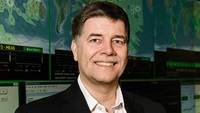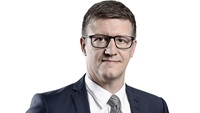Top 10 technology leaders 2019
MAN Energy Solutions tops our list of technology businesses that have made the greatest contribution to changing the shipping industry for the better in 2019
As part of our annual Lloyd's List Top 100 most influential people in shipping on December 13, we look at the movers and shakers in maritime next-gen technology
01 / Uwe Lauber, MAN Energy Solutions
MAN Energy Solutions has pushed deeply into the digital transition this year, making it a core element of its corporate strategy.
It created a new digital platform, MAN CEON, to intelligently collect and evaluate operating and sensor data, while enabling the real-time monitoring of marine and power-plant engines, turbines and compressors.
To further this initiative, the company has formed partnerships with Kongsberg and the South Korean shipbuilders Samsung Heavy Industries and Daewoo Shipbuilding & Marine Engineering. In September, it joined the Getting to Zero Coalition.
Chairman Uwe Lauber is working to decarbonise fuel — especially in container shipping — as a path to decarbonising the maritime economy.

02 / Klaus Heim, WinGD
WINGD (rebranded from Winterthur Gas & Diesel) this year introduced three new low-speed two-stroke engines capable of operating on low-emission fuels. Chief executive Klaus Heim said this was in response to owners’ calls for sustainability and improved efficiency from marine propulsion.
In September, the company announced the development, with ETH Zürich, a technical university, of an advanced algorithm to enhance predictive maintenance for two-stroke engines.
The diagnostic system has been made available for all new WinGD engines ordered since early 2018 and, it is claimed, will increase the capability to predict and prevent engine failures far beyond what can now be done.

03 / Jaakko Eskola, Wärtsilä
WARTISLA'S acquisition spree continued in 2019 with the takeover of the small UK-based navigation and comms specialist Ships Electronic Services.
This followed, among others, Burriel Navaro and Transas in 2018, Trident and Puregas Solutions in 2017, and Eniram in 2016.
The company has embraced the concept of ‘Smart Marine’, driving towards positive disruptive development.
Finances were boosted in 2018 by a hike in orders for scrubbers but this year Wärtsilä suffered from reduced newbuilding business and fewer scrubber orders.
President and chief executive Jaakko Eskola cautioned that competition is intensifying and “price pressure remains a headwind.” Even so, forward planning is market-leading.

04 / Juha Koskela, ABB marine and ports division
AT the beginning of the year, ABB restructured around four businesses: electrification, industrial automation, motion, and robotics and discrete automation. The marine and ports portfolio fits into industrial automation, focusing on industry-specific, differentiated automation solutions.
Macro-economic weakness has hit maritime as well as other markets. However, ABB’s long-term strategy continues.
A contract has been won from Keppel Offshore & Marine, a Singapore shipyard, to provide the technology for autonomous tug operation at Port of Singapore.
Juha Koskela, managing director of ABB’s marine and ports division, described the project as “a key marker on our digital journey.”

05 / Sameer Kalra, Alfa Laval
MARINE hardware encompasses pumping systems, boilers, heat transfer equipment, high-speed separators, ballast water and exhaust gas treatment systems.
Mid-year reports revealed orders for PureSOx scrubbers showed significant decline — caused by uncertainty regarding availability and price of alternative fuels, whereas orders for PreBallast systems was very strong — the result of implementation of legislation on ballast water treatment systems.
As shipping turns its attention to liquefied natural gas as a fuel, Alfa Laval’s boiler technology is reported to be well positioned to enable vessels to deal with boil-off gas, a critical step in the transition.
Sameer Kalra took over as head of the marine division in January 2019.

06 / Geir Håøy, Kongsberg
HAVING acquired Rolls-Royce Commercial Marine in April this year, it is now unified and combined as Kongsberg Maritime, with cost synergies through co-location, reduction in workforce (about 450) and support functions, streamlining of IT, and product optimisation.
The company claims to have marine technology on 30,000 vessels.
President and chief executive Geir Håøy reported a good order intake within marine robotics and the after-sales market, although somewhat weaker for the newbuilding market.
An agreement with Shell on the digitalisation of Nyhamna gas plant has placed Kongsberg Digital at the forefront in the market for dynamic digital twins, which could boost twinning for shipping.

07 / Ronald Spithout, Inmarsat Maritime
THE mobile satellite communications company launched its Fleet Xpress platform in 2016, with faster speeds and improved bandwidth compared with its earlier FleetBroadband.
Fleet Xpress is now installed on 7,500 ships and will increasingly form the foundation of a data analytics ecosystem.
Ronald Spithout, president of Inmarsat Maritime, said containerships are doing a terabyte of data (1,000 gigabytes) a month.
“We are now seeing the first signs of the connected vessel,” he said.
The company has eight new satellites on order, ready to be launched, stationed, tested, and tuned in by 2023. By then, the connected vessel will be a reality.

08 / Henrik Uhd Christensen, Viking Life-Saving Equipment
VIKING’S acquisition of Norsafe, the Norwegian lifeboat manufacturer, was completed late in 2018.
The two Scandinavian family-owned businesses were able to extend their global footprint. This was especially the case for training, where newly branded Viking Norsafe’s specialised centres in Norway and Greece offered both product and STCW courses.
The move follows the earlier acquisition of Danish marine fire service business Skandinavisk Brandteknik.
Chief executive Henrik Uhd Christensen says the next stage is to target operators who are looking to entrust safety-related matters to a single provider.
The Shipowner Agreement umbrella has been significantly extended, making Viking a leader in the marine safety field.

09 / Matt Desch, Iridium
THE Virginia-headquartered communications business led by chief executive Matt Desch is in the process of replacing its satellite constellation with 75 new satellites — 66 of them to be used, the rest for spares in the new Iridium Network.
This will enable the company to end Inmarsat’s 20-year monopoly on the provision of safety comms services.
In June 2019, the first piece of equipment designed for the Iridium GMDSS system was launched by Lars Thrane, a partner with Iridium.
The LT-3100S GMDSS system is designed for all IMO vessels and will be an alternative to the Inmarsat C. It also offers SSAS (ship security and alert systems) and LRIT (long range identification and tracking) functionalities.

10 / Marius Johansen, Wilhelmsen Ships Agency
AFTER a long period of planning, this year an Airbus drone navigated autonomously along a pre-determined aerial corridor between Wilhelmsen Ships' service base at Marina Pier South in Singapore and a Swire Pacific Offshore AHTS vessel.
When it had deposited its 1.5 kg cargo, which included items from Wilhelmsen’s 3D printing micro-factory, the drone returned to its base.
Marius Johansen, vice-president commercial at Wilhelmsen Ships Agency, said stakeholders’ faith in the concept of Agency by Air drone delivery had not been misplaced. It is hoped the coming year will see the delivery of spares, medical supplies, and cash to Master transferred from sea to air.
The Top 10 technology leaders list is compiled by the Lloyd's List editorial team and considers people and companies that are driving real digital change across the maritime industries
